Doge's Palace Art Story | Location | Opening Hours Tickets | Authorizations
Art Story Power | Tintoretto Paradise | Architecture | Staircases | Senate Collegio | Atrium
Jacopo Robusti Tintoretto Paradise at Venice Doge's Palace
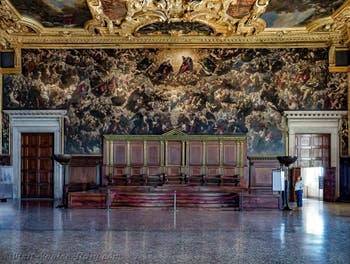
Tintoretto, Paradise Tintoretto "Paradise" in the Grand Council Hall of the Doge's Palace: a canvas 24.5 metres long and 9.90 metres high!
In 1587, the Venice Senate decided to replace the old fresco of Guariento de Padua with an oil painting on canvas.
This fresco decorating the Grand Council Hall of the Doge's Palace was painted in 1365 only on the part of the wall just above the ducal throne; unfortunately, it had been severely damaged by a fire in 1577.
They wanted to replace it with a grandiose work, which this time would occupy the entire width of the room.
A competition was organized to find the artist capable of producing a masterpiece worthy of this prestigious place.
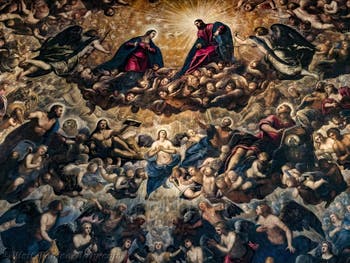
Tintoretto, Paradise Finally, it was necessary to choose between the two best: either the exceptional palette of Paolo Veronese perfectly adapted to the subject, or the variety and vivacity of Tintoretto.
Since Tintoretto was already 68 years old, some thought it was too old to do a work of such magnitude.
Paolo Veronese won the commission, and it was expected that he would be assisted by a talented colourist painter: Francesco Bassano.
Unfortunately, in 1588 Veronese died even before he had finished his draughts.
As a result, Tintoretto inherited the order, and immediately began to work.
Tintoretto "Paradise": A Grandiose Work
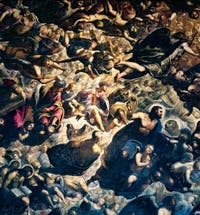
Tintoretto, Paradise The aim was to paint a work on canvas 24.5 metres long by 9.90 metres high; however, no one had faced such a challenge since Michelangelo painted the Sistine Chapel.
To do this, Tintoretto used the large room of the Chapter of the Scuola Vecchia de la Misericordia as a workshop.
It was an excellent choice because he lived in the Cannaregio District, near the Misericordia, so he could get there in a short time and the Sensa Canal made it easier for him to organize logistics.
He prepared his work thoroughly by dividing his painting into several sections before assembling them to check the overall harmony, and he started again...
To end up in this incredible crowd of weightless characters.
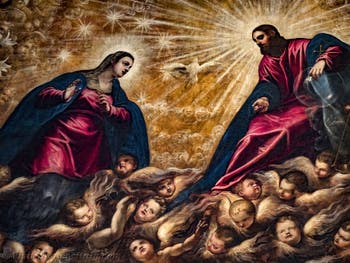
Tintoretto, Paradise He was assisted by his son Domenico, notably in the final realization on site at the Doge's Palace, where it was necessary to constantly climb and descend scaffolding to get an overview after each operation.
This explains the differences in the representation of some characters, but it is easily noticed that the most important ones are always perfectly represented and therefore easily identifiable, proof that they were completely painted by the master.
Tintoretto knew perfectly well about human anatomy, but this did not prevent him from referring to statues embodying the ideal of female beauty, nor from having living models and obtaining religious clothing for the sake of realism and precision.
John Ruskin and the Paradise of Tintoretto
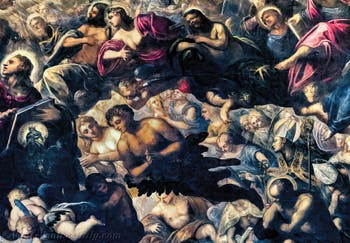
Tintoretto, Paradise The dominant colours of the Paradise character’s clothes range from crimson to bright purple, raised by shadows that stand out from a background of light that radiates the whole picture.
The famous John Ruskin admired:
"This ocean of faces expressing all forms of perfect joy, which gives you the impression of being in heaven."
Imagine the Assembly of the Great Council of Venice sitting in this huge room, opposite the ducal throne and the "ocean of faces" illuminated by the heavenly light emanating from the figure of Christ which dominates the central square of the painting.
The Paradise of Tintoretto: An ideal painting
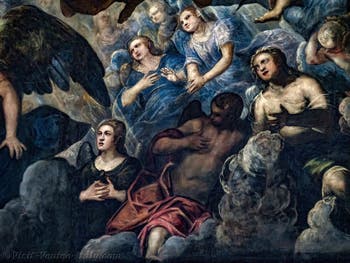
Tintoretto, Paradise This crowd of blessed deserving represented a magnificent model of serenity and harmony for the Grand Council which ruled the Republic of Venice, under the presidency of the doge.
The word paradise comes from Persian paridaiza, which means garden, enclosure.
Originally paradise is indeed "earthly", it is the Garden of Eden where Adam and Eve lived, until the day they were driven out of it because they had disobeyed God by committing the first sin: the "original" sin that inaugurated the separation of their descendants (Humanity) from the Creator.
The Paradise of Tintoretto is a "Heavenly" Paradise
The paradise of Tintoretto is not the Eden of Genesis where God had placed them by offering them all the fruits of the earth, but the heavenly paradise promised by Jesus Christ to his disciples.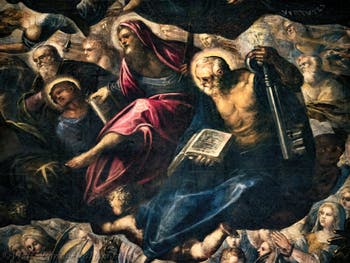
Tintoretto, Paradise It is not a mere abandonment of oneself to divinity, but an act of faith, a participation in the eternal joy and peace that triumph over death and suffering.
No certainty as to the existence of the afterlife, the Tintoretto Paradise is an artistic vision comparable to David's Psalm or Dante's Paradise.
Tintoretto knew perfectly well the difference between his painting of "Paradise" as a purely imaginary creation belonging to the history of the human soul, and that of the "Crucifixion" (at the Scuola San Rocco) representing a real, historical fact.
For Tintoretto, as for Dante, the Paradise of the Blessed was not a mere future, but the present reality of a soul rising to the Divine.
The "Paradise" illustrates this call to the infinitely perfect.
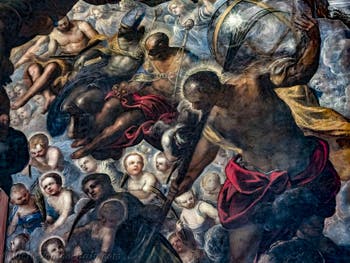
Tintoretto, Paradise "Paradise" represents the fulfilment of the desire for completion that characterizes the human being, the fulfilment of his "dream of a sunrise before dawn".
We are fascinated by the rounds of saints and blessed who shake around the royal couple: Christ and Mary are at the centre of the celestial movement, the eye of a cyclone of golden light.
The Grand Council Chamber opens to the sky.
We are surprised at this crowd of magnificent figures whose faith in God has marked the history of Judaism and Christianity, characters who are to identify by recognizing the attributes that characterized their actions, or their sufferings, for the sake of God.
The Symbolism of the Paradise of Tintoretto at the Doge's Palace
Jesus Christ and the Virgin Mary in the Paradise of Tintoretto
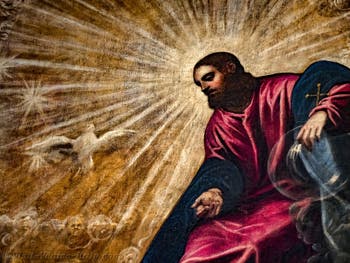
Tintoretto, Paradise Like the sun at the zenith, Jesus Christ is at the top of Paradise, which He illuminates with all his fires.
His left arm is placed on a dark crystal globe representing the earth.
This radiant Christ turns to the Virgin Mary his mother, who is on his right hand; she confirms her love by humbly greeting him, and seems to repeat the words she had spoken on the day of the Annunciation: "I am the servant of the Lord."
The Paraclete (the dove symbolizing the Holy Spirit) and the Angel Gabriel with the three white lilies of the Annunciation are with the Virgin Mary to recall this extraordinary day when God incarnated, because it is the founding event of Christianity.
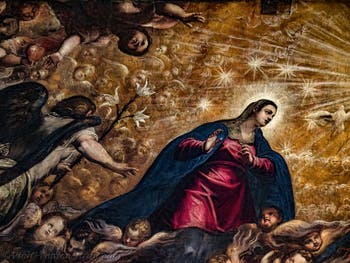
Tintoretto, Paradise The expression of his beautiful face resembles that of the Madonna of the Sistine, and Christ has the same features as that of "the healing of the sick and the lame" painted by Veronese.
Both are dressed in drapes in the style of Veronese: out of respect for him, Tintoretto would have been inspired by the drawings he had made before his death.
Mary is halved by seven highly symbolic stars: according to the Revelation of John I v. 20,
"The seven stars are the angels of the seven churches, and the seven lamps are the seven churches."
The seven churches in question referred to early Christian communities located in the main cities of Asia Minor under Roman rule: Ephesus, Smyrna, Pergamon, Tyatira, Sardinian, Philadelphia and Laodicea.
The Archangels and Angels of Paradise of Tintoretto
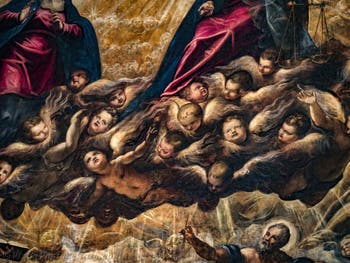
Tintoretto, Paradise The supreme couple is surrounded by all the angels of Heaven: seraphim (angels of the highest level of dignity), cherubim, archangels... all these spiritual beings that inhabit the nine circles of Dante's paradise.
Cherubim and seraphim have ruby-red wings.
The angel who flies to the right hand of Christ is the Archangel Michael, the one who examines the actions of men and weighs their merits, he holds a balance in his left hand and a sword in his right hand.
It is followed by other angels who carry crystal globes, symbols of sovereignty and purity, these are the thrones (kingdoms of righteous spirits).
Next to them are also represented the Principalities (principalities of passionate spirits) cited in the paradise of Dante.
Thrones carry scales while the angels of the Principalities carry globes topped by a cross.
The Four Evangelists in the Paradise of Tintoretto
Just below the beings at the top of the celestial vault, we see the four Evangelists surrounded by a crowd of angels flying in every direction to serve and support them.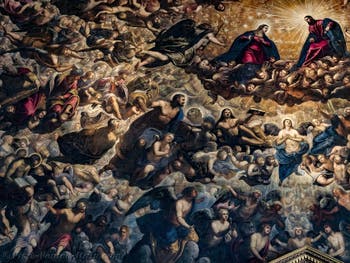
Tintoretto, Paradise From left to right:
St Mark, the patron saint of Venice, who turns his head towards his winged lion full of indulgence and seems to show him the text he has just written about the life of Jesus.
Saint Luke, who was a painter and doctor, is installed "in the Roman fashion", leaning on an elbow while raising the other arm that carries his gospel in a gesture of offering.
We can see the head of an ox lying behind him.
Saint Matthew, draped in blue, with his right arm raised after dipping his stylus in the inkwell held by a cherub, looks up to heaven before continuing to write the story of Jesus Christ.
Saint John, dressed in red, is writing his Apocalypse, his face turned towards the sky, fascinated by the Divine... his spirit flies to the tops, symbolized by the eagle halved with light seen in his book.
The Divine Light in the Paradise of Tintoretto at the Doge's Palace
In the centre of Paradise of Tintoretto: the Archangel Raphael.Between the four Evangelists, an angel in prayer, the Archangel Raphael, occupies the centre of the painting.
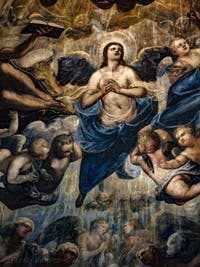
Tintoretto, Paradise His face is imbued with the melancholic sweetness characteristic of the little Saint John the Baptist who looks at the Child Jesus.
He is bare torso, in full light, his face lifted in adoration to Christ the Saviour: he leaves the gravity of his blue garment in the image of a soul leaving his body, and ascends to Him in a column of light.
Surrounded by beautiful angels full of concern, this body in full light attracts the eye because it is at the centre of the cross formed by this vertical axis with the horizontal alignment of the four Evangelists.
At the bottom of the painting, a woman dressed in yellow looks at him, spreading her arms, this is the guardian angel of the sea.
Tintoretto organized Paradise around this vertical axis starting from this woman who looks at the angel who looks at Jesus looking at the Virgin Mary.
The Great Characters of the Bible in the Paradise of Tintoretto
In the left part of the painting, to the left of Saint Mark, one easily notices the great characters of the Bible, always dressed in drapes with bright colours, very expressive, and particularly well represented by Tintoretto.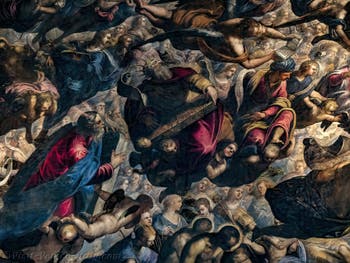
Tintoretto, Paradise Moses in blue and red carries the Tables of the Law, the rays of light springing out of his venerable head and his beautiful spirituality face reveal the wisdom man who received the divine message on Mount Sinai.
Behind Moses, the old man in blue and yellow releasing his knife is Abraham, the hero of faith in God ready to sacrifice his son Isaac, whom he holds by his hair.
David, the great king of Israel full of nobility and courage, plays the cither and fervently sings his famous Psalms.
On his right hand, the man with a turban is King Solomon; he leans towards a white-haired bare torso man with the Ark and the dove, that is Noah the righteous, whom God has chosen to save living beings from the flood.
To the right of Solomon, both with an interurban head, are the prophets Isaiah and Amos, who holds a book on his knees.
Saints and Martyrs of Paradise of Tintoretto at the Doge's Palace
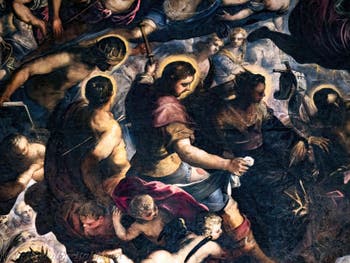
Tintoretto, Paradise Around these great figures of the Old Testament, there is an innumerable crowd of saints holding the palm of martyrdom, among whom we recognize:
Saint John the Baptist, with a lamb and his staff topped by the banner cross, whose camel hair garment is covered with a pink cloth.
He sits on the shoulders of a flying angel behind Moses's back.
Saints of the left part of Paradise du Tintoretto
To his left, Saint Roch the healer of the plague who shows his bubo on his thigh, then Saint-Louis, leaning over Saint Sebastian whose torso is pierced by an arrow, and finally Saint Beard standing near his tower, eyes lowered on the book held by the crowned saint leaning towards Sebastian.To the right of Saint Barbe, the luminous beauty of a holy woman full of sweetness.
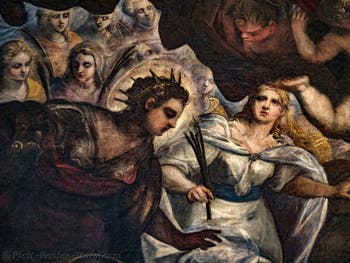
Tintoretto, Paradise Saint Lucia of Syracuse, martyred and blind, is the young blond woman in a white dress who advances a hesitant hand towards Abraham.
To his left, the figure full of wisdom hallowed with light of Saint Justina of Padua who wears the royal crown and majestically holds her great palm in the right hand; her dark clothes underline the radiant beauty of the young women around her.
Above her, dressed in blue is the beautiful face of Saint Agnes.
Behind them, a great ascetic monk carrying the stigmas comes humbly, the crucifix in his hand: Saint Francis of Assisi, founder of the Franciscans Order.
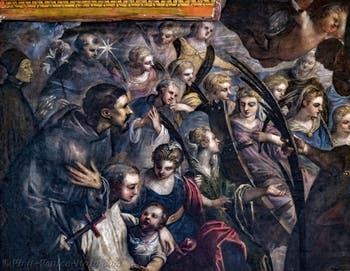
Tintoretto, Paradise Above him, another monk with a white lily in his hand and a star in front of his forehead: Saint Dominic, founder of the Dominican Order.
In front of Saint Francis of Assisi, dressed in white with a child under his arm, is Saint Bernard of Clervaux, at the foot of which is depicted a demon's head, symbol of Saint Bernard's victory over temptations.
Some think that it could also be Saint Anthony of Padua, usually represented with a child.
At the bottom of the painting, in knight's armour, Saint George became famous for killing the dragon with his spear.
He leans to the right where we see some well-lit faces, including that of a bearded man in blue looking at a young woman next to him.
Adam and Eve in the Paradise of Tintoretto
To the right of the four evangelists, next to the eagle of Saint John, we see Eve with blond hair and immaculate skin flying in the company of Adam, whose lower body is covered with leaves.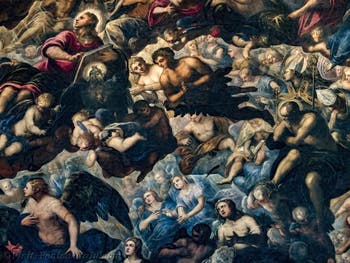
Tintoretto, Paradise The primordial couple driven out of earthly paradise regained their original purity thanks to Jesus' sacrifice: they found God in Heavenly Paradise thanks to Christ the Redeemer who erases the sins of the world.
Above Adam and Eve, the weightless Apostles all look to the left.
Among them, St. Thomas is distinguished with a square symbolizing his profession as an architect and his rational spirit, which wanted to concretely verify the resurrection of Christ by touching the wounds of the crucifixion.
At the end of the line of the Apostles, the old man with a conscious forehead with a book and a key in his hand is Saint Peter, the famous founder of the Church of Rome.
He is followed by a young and dynamic man with the sword on the side that represents Saint Paul, the tireless preacher traveller, determined to convince and convert the world.
Doctors of the Roman Church in the Paradise of Tintoretto
To the right of Saint Paul, a host of great figures of the Catholic Church beautifully represented by Tintoretto: popes, cardinals, bishops, wearing their priestly garments with tiara or mitre. These are the doctors of the Roman Church: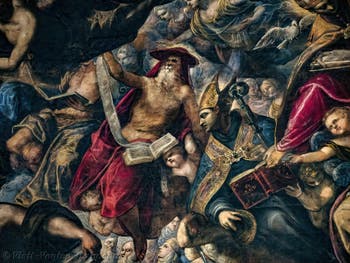
Tintoretto, Paradise Saint Jerome, the hermit of the desert, is bare torso, draped in red with his white beard and cardinal hat, holding his manuscript at arm's length.
During the years 390-405, he had translated the Bible into Latin from the Hebrew text: the Vulgata. First challenged by the defenders of the Greek Bible, it was not until the Council of Trent of 1546 that its Vulgata was declared canonical.
Saint Ambrose (337-399) is to the right of Jerome, in blue and gold with his book on his knees.
Arriving in Milan as governor of Emilia Liguria, he was baptized in the year 370 and immediately elected bishop by Christians.
This great theologian who struggled against Arianism is known for having forced the Emperor Theodosius to a public atonement, and for having baptized St. Augustine, who considered him a master and model of piety.
Paradise of Tintoretto: Thomas Aquinas, Saint Augustine and Mary Magdalene
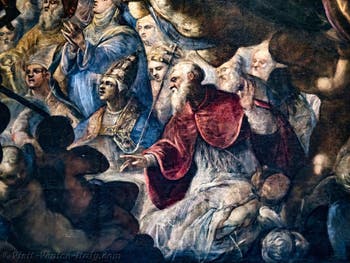
Tintoretto, Paradise Just below Saint Ambrose, the venerable character in white dress with a red cape that discusses next to the pope in blue wearing the tiara, is probably the famous Thomas Aquinas (1228-1274).
Thomas Aquinas, the Italian Dominican nicknamed "the Angelic Doctor", is the author of the famous Summa Theologica.
He taught in Paris, Naples and the Roman Curia.
And the bishop between the pope in blue and Saint Paul could be Albert the Great (1206-1280) bishop of Regensburg.
Born in Germany, he taught in 1260 in Paris, where Thomas Aquinas was his pupil.
Albert the Great showed the importance of Aristotelian philosophy and made known the works of Arab philosophers and scientists.
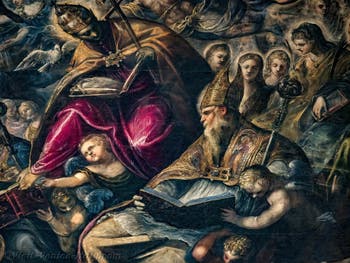
Tintoretto, Paradise Saint Gregory (540-604) is the great pope in red and gold with his pontifical cross, leaning over the great book on his knees, it was he who instituted the "Gregorian" chant and sent priests to evangelize the British people.
He proclaimed himself "the servant of the servants of God"; this beautiful formula was maintained, and passed on as a title to all his successors.
Augustine (354-430), the famous bishop of Hippo (North Africa), is the author of the Confessions and the City of God.
Son of a pagan, baptized at the age of 32, Augustine is a thinker who had converted to Christianity not only thanks to Neoplatonism, but also under the influence of the great piety of Monica, his mother.
Augustine meditates with serenity before the eyes of his mother sitting behind him amidst other women, leaning right above his crozier.
Mary Magdalene and Saint Christopher in Tintoretto Paradise
Mary Magdalene the sinner occupies the extreme right of the painting under the traits of the beautiful and tall woman in red and yellow surrounded by angels who carry her respectfully.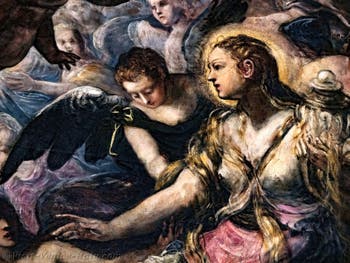
Tintoretto, Paradise At the bottom of the painting, symmetrically in front of St. George, as big and powerful as the legendary Atlas, here is the athletic Saint Christopher Protector of Travellers, the one who had carried Christ on his shoulders to make him cross a dangerous river.
Tintoretto depicted him helping a woman, Rachel, surrounded by many children to cross the waves, while carrying on his shoulders the enormous celestial globe topped by the cross symbolizing the world and its creator; with one hand he pulls on his large staff that resembles an oar: Saint Christopher is in charge of the Traghetto!
One could continue to observe this great painting of Paradise for a long time to identify all those blessed, each with a particular face and a different attitude.
They are all busy doing something: praying, preaching, reading, playing music, praising God, writing, meditating, contemplating... singing.
The Paradise of Tintoretto is a symphony, a living tourbillon where everyone finds its place among the many ethereal silhouettes and faces that fade under a veil of bluish light.
Art Story Power | Tintoretto Paradise | Architecture | Staircases | Senate Collegio | Atrium
Doge's Palace Art Story | Location | Opening Hours Tickets | Authorizations
Back to Top of Page

